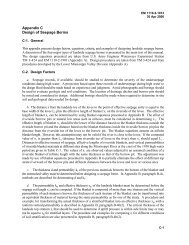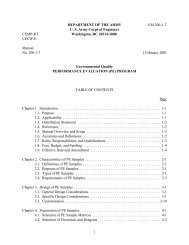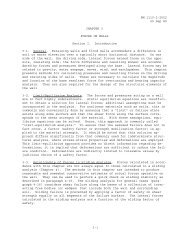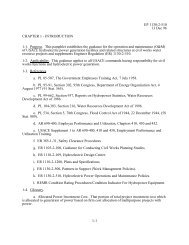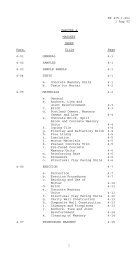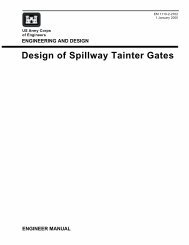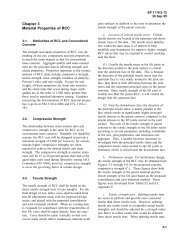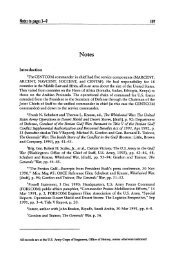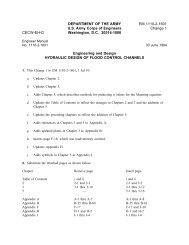Chapter 5 - Publications, US Army Corps of Engineers
Chapter 5 - Publications, US Army Corps of Engineers
Chapter 5 - Publications, US Army Corps of Engineers
Create successful ePaper yourself
Turn your PDF publications into a flip-book with our unique Google optimized e-Paper software.
EM 1110-2-1701<br />
31 Dec 1985<br />
(2) For some run-<strong>of</strong>-river projects, a constant reservoir<br />
elevation can be specified, but for others, it may be necessary to<br />
develop a forebay elevation versus discharge curve. For run-<strong>of</strong>-river<br />
projects with pondage, reservoir elevation will vary from hour to<br />
hour, and the average daily elevation may vary from day to day. In<br />
the hourly modeling <strong>of</strong> peaking operations, this variation in elevation<br />
must be accounted for, and storage-elevation data must be provided in<br />
the model. However, when these proJects are being evaluated for<br />
energy ~tential, and daily, weekly, or monthly time intervals are<br />
being used, an average pool elevation should be specified. The<br />
average elevation can be estimated from hourly operation studies, and<br />
it may be specified as a single value or as varying seasonally (for<br />
example, assume a full pool in the high flow season and an average<br />
drawdown during the remainder <strong>of</strong> the year).<br />
(3) When using the flow-duration method, either a fixed<br />
(average) reservoir eleVatiOn or an elevation versus discharge<br />
relationship must be assumed for all types <strong>of</strong> projects. When using<br />
the hybrid methodg reservoir elevations are obtained for each interval<br />
from the historical record or from a base sequential streamflow<br />
routing study.<br />
(1) Three basic types <strong>of</strong> tailwater data may be provided:<br />
. a tailwater rating curve<br />
● a weighted average or ‘block-loadedW tailwater elevation<br />
● elevation <strong>of</strong> a downstream reservoir<br />
(2) For most run-<strong>of</strong>-river projects or projects with relatively<br />
constant daily releases, a tailwater rating curve would be used. At<br />
peaking projects, the plant may typically operate at or near full<br />
output for part <strong>of</strong> the day and at zero or some minimum output during<br />
the remainder <strong>of</strong> the day. In these cases, the tailwater elevation<br />
when generating may be virtually independent <strong>of</strong> the average<br />
streamflow, except perhaps during periods <strong>of</strong> high run<strong>of</strong>f. For<br />
projects <strong>of</strong> this type, a single tailwater elevation based on the<br />
peaking discharge is <strong>of</strong>ten specified. It could be a weighted average<br />
tailwater elevation, developed from hourly operation studies and<br />
weighted proportionally to the amount <strong>of</strong> generation produced in each<br />
hour <strong>of</strong> the period examined. In other cases, it might be appropriate<br />
to use a ‘block-loadedW tailwater elevation, based on an assumed<br />
typical output level (Figure 4-7).<br />
(3) There is sometimes a situation where a downstream reservoir<br />
encroaches upon the project being studied: i.e., the project being<br />
studied discharges into a downstream reservoir instead <strong>of</strong> into an open<br />
5-30




